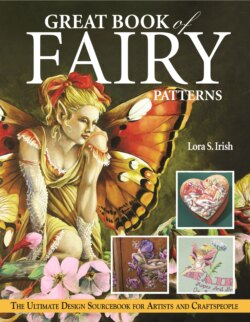Читать книгу Great Book of Fairy Patterns - Lora S. Irish - Страница 19
На сайте Литреса книга снята с продажи.
Оглавление11
G
REAT
B
OOK
OF
F
AIRY
P
ATTERNS
Recurring themes in the old tales
Just as you find different descriptions of Fairies
in the oldest legends, you also find a wide variety
of themes and story lines. Just about anything you
could ever imagine can happen if one encounters
a Fairy, and then the adventure would be told and
retold until it became what we might today call an
“urban legend.”
There does seem to be a small handful of sto-
ries that appear to repeat and that are not bound
to one particular location or time period. These
are the Fairy tales that use the magic of the race
to explain odd instances and unexpected occur-
rences in the lives of people. Several stories are
excellent examples of this. Let’s explore just a few
to discover the basic idea behind the Fairy tale.
The Tale of the Fairy Ring Dance
A story that is often told revolves around the
Fairy ring dance and is an old version of
Rip van
Winkle
by Washington Irving. This story begins
late at night as a man is walking along a wood-
lined, deserted road. (Human women, for some
unknown reason, do not appear in this particular
story.) Suddenly he hears the sweet melody of the
fiddle and the pipe coming from under a large tree
just a short way from the roadbed. Curious and
drawn by the lovely music, he creeps toward the
tree to discover a band of Fairies dancing merrily
around and around the tree’s base. A lively Fairy
maiden grabs the man’s hand as she passes by him,
encouraging him to join in the fun.
As the evening goes by, he abandons his hesi-
tation and throws himself into the spirit of the
evening, enjoying every twist and turn of the
dance. When dawn’s light creeps into the woods,
the man is overcome with weariness and finally
pulls himself away from the merriment to fall
asleep on a bed of soft grass. Little does he know
as he drifts off that it will be anywhere from one
year and one day to five hundred years later when
he awakes or that he will return to a human world
that is strangely changed and unknown to him.
When this poor soul does finally make it home, he
discovers that everyone he has ever known has
died, his house has been long sold, and there is no
one who knows anything about him, except for a
small piece of old gossip about the “man who
never came home.” Many of the variations of this
story end with the man, now decrepitly old, turn-
ing to dust before the next sunset.
The main character of “The Tale of the Fairy
Ring Dance” seems to fall into one of three types.
The first character type is the overly responsible
man. This gentleman finds himself doing more
labors than he physically can stand as no one else—
neither wife, nor children, nor grandchildren—will
lend themselves to the work. He often is noted as
having a demanding wife with a wicked tongue, who
may have managed to create a large debt due to her
spending well beyond his meager means.
The second type of man that shows up in the
tale is the misunderstood son. These versions tell
about a young man who, no matter how hard he
works or applies himself to his lessons, can never
accomplish as much as his sire expects of him.
The boy will be noted as having struggled for years
to earn even one small scrap of respect from his
father. Though he will have achieved more than
any other man of his age in the village, in his
father’s eyes he will always be a failure.
The third character type that appears in these
stories is the chronic drunk. This version usually
begins with noting that the man is, once again
(since it is a regular practice), returning home
from the village tavern after a hard evening of
drinking. It is also noted in these stories that his
wife, who is waiting at home, is ready to once
again deliver a firm tongue-lashing in response to
his drunken state.
It would be a major topic of gossip in any small
village if one day a man disappeared, never to be
seen nor heard from again in the lifetime of his
family and friends. In reading the tales it seems that
any of these men might have finally had enough of
